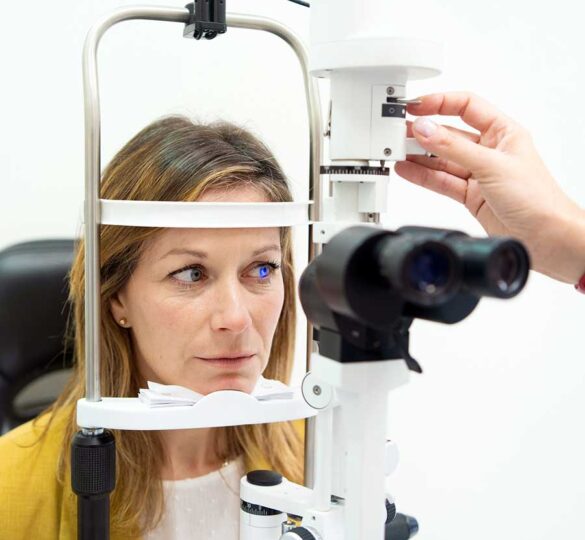Normal-Tension Glaucoma: What You Need to Know
Learn about the features, risk factors, and treatments for normal-tension glaucoma.

Glaucoma is a group of diseases that have different causes but have some things in common. These include damage to the optic nerve, abnormalities in the visual field, and elevated intraocular pressure. But there is a subset of patients who have the typical findings seen in glaucoma, yet the intraocular pressure is not high. Eye doctors call this normal tension glaucoma (NTG).
It is also sometimes called low pressure or low-tension glaucoma, but the eye pressures aren’t low, they’re just in the average range. Some patients may have normal tension glaucoma for many years and then develop high eye pressure. So, patients with NTG will need to see their eye doctor frequently for regular, careful testing.
The good news is that doctors are very good at measuring the progression of glaucoma, and treating it to slow or halt the progression, so that most patients can enjoy a normal quality of life.
NTG Features and Risk Factors
In normal tension glaucoma, the optic nerve is damaged without eye pressure exceeding the average range (between 10-21mm Hg). Some NTG patients have higher pressures during the early morning hours between 2:00 AM and 6:00 AM when the blood pressure is lowest. This can contribute to the glaucoma progressing. Low diastolic blood pressure is a common association with normal tension glaucoma. Diastolic pressure is the bottom number in a blood pressure reading. And when the bottom number is too low, that is a risk factor for glaucoma progression.
Patients with normal tension glaucoma tend to be older than those with primary open-angle glaucoma (POAG), but there’s a subset that is younger and tend to be women. Japanese ancestry is also a risk factor. In one large study of glaucoma patients of Japanese ancestry, 92% had NTG.
Sleep apnea can be associated with either NTG or POAG. It’s also common for a patient with normal tension glaucoma to have vascular dysregulation such as migraine headache, Raynaud Syndrome (when fingers and toes turn white when exposed to cold), temperature sensitivity, and light-headedness.
Another risk factor for normal tension glaucoma, just as for high pressure glaucoma, is a thin cornea. Some patients with NTG develop transient hemorrhages of the optic nerve, which can also occur in patients with POAG, but they are more common in NTG.
Treating Normal Tension Glaucoma
The mainstay of treatment is to lower intraocular pressure, using all the same treatment methods that are used to treat POAG. These include medication eye drops, SLT laser treatment, sustained-release medication implants, cataract surgery combined with MIGS (minimally invasive glaucoma surgery), or traditional surgery such as trabeculectomy. One of the treatment goals is to maintain a steady eye pressure. Patients with NTG need frequent eye examinations and testing to ensure that the treatment is effective and the condition isn’t worsening.
Frequently Asked Questions
How is a patient’s optimal pressure range determined?
Usually the doctor will start out by setting a pressure “target” for you based on various factors including the severity of the disease, what part of your visual field is experiencing vision loss, and what your baseline pressure is. Once the target pressure is achieved, then your doctor will follow your progress carefully to make sure the target has been set correctly.
If I have normal tension glaucoma in one eye, will it eventually affect my other eye?
Often whatever processes are causing the glaucoma in one eye are affecting the other eye too. Some patients may have a long span of time before the glaucoma affects the other eye. So yes, it’s possible just to have glaucoma in one eye, but your doctor will carefully monitor your other eye in case the other eye develops it later.
Is normal tension glaucoma hereditary?
Anytime you have a family history of glaucoma, it increases your risk of glaucoma. But just because you have a parent or even two parents with glaucoma doesn’t mean you will get glaucoma, whether high pressure or normal tension glaucoma. It just increases your risk. Also, if your sister or brother has glaucoma, that’s an increased risk for you. Anyone who has a family member with glaucoma should get a comprehensive eye exam.
What types of exercises are safe for normal tension glaucoma patients?
Valsalva type maneuvers such as playing a trumpet, lifting weights, or doing resistance exercises will temporarily raise intraocular pressure. The question is how much and for how long? Typically, I tell my patients, if your eye pressure is well controlled and you’re doing fine, it’s generally safe to do those things. Inversion — hanging from your feet upside down — raises eye pressure and long sessions are not recommended for glaucoma patients.
What can I do in my day-to-day life to keep my glaucoma from worsening?
It’s important that you don’t smoke. Also, a healthy diet is very important for your nerve health and overall health. Minimize processed foods and eat as many fresh fruits and vegetables as possible. A lifestyle that includes exercise, a good diet, and no smoking contributes to a healthy vascular and neurological system, which impacts the eye.
Video: Normal Tension Glaucoma
Article by Ruth D. Williams, MD. Posted on August 8, 2024.

Ruth Williams, MD
Ruth D. Williams, MD is a glaucoma specialist at the Wheaton Eye Clinic in Wheaton, Illinois. She is a past president of the American Academy of Ophthalmology and a national spokesperson on ophthalmic issues.